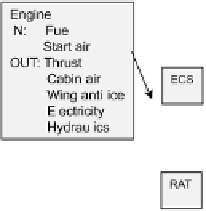Environmental Engineering Reference
In-Depth Information
Source:
Birch, 2000
Figure 10.9
The More Electric Aircraft
Biomass-derived fuel is a prospective candidate, but still has several obstacles to over-
come. The Fischer-Tropsch synthesis process (F-T) can successfully create sulphur-free
kerosene from natural gas, coal and biomass sources. The use of biomass as the
source for the fuel significantly reduces the net amount of CO
2
released into the
atmosphere, as that released during the combustion of the fuel will have been previ-
ously absorbed when the biomass was growing. However, biomass-derived fuel can-
not be completely CO
2
neutral, as energy is required to operate the F-T process.
Additional benefits are that existing engine configurations would not need to
undergo large modifications to use the fuel, and airport infrastructure could be eas-
ily upgraded to cope with the new fuel. Synthesised kerosene is already produced in
South Africa by SASOL, indicating that this has commercial potential as an alterna-
tive fuel.
The synthesis of biomass-derived fuel could offer a short-term, easily integrated,
solution to CO
2
emissions from aircraft. It may be possible that biomass fuel would
provide a 'breathing space' to allow more radical technology to be fully developed.
However, biomass-derived kerosene requires additional research in order to evaluate
the potential CO
2
savings, to determine the land area required to grow sufficient
biomass, and to assess the environmental effects associated with the increased agri-
cultural requirements (such as increased use of fertilizers, their manufacture and
their effects on groundwater).
Hydrogen-powered aircraft potentially offer a solution to one of the major envi-
ronmental problems facing aviation: global climate change through the emission of
CO
2
. With respect to weight, liquid hydrogen has 2.8 times more energy than kero-
sene, (Klug, 2000),
and the major product of its combustion is water. Some of this
energy advantage will be lost because of the increased complexity and weight of the
fuel system, and especially because of the large tanks required to store the fuel. These
large tanks lead to an unusual configuration of a hydrogen-powered aircraft. For large
passenger craft, the most common solution is a traditional configuration with the





































































































































































































































